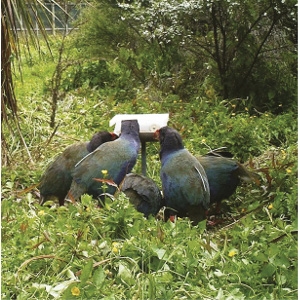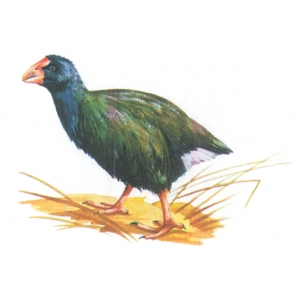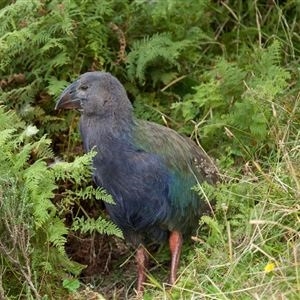Displaying items by tag: Takehe
Thursday, 23 August 2018 21:06
Takahē take to new home
In October last year we released 10 takahē intoTāwharanui Open Sanctuary, North Auckland.This nationally critical species has come to Tāwharanui as a secure site that may enable breeding to improve the population and its conservation status.
Despite being released 2km in a straight line from the Mangatawhiri wetland and further as the takahē trundles, six of the 10 birds havechosen to take up residence here for several weeks and now appear very stable and settled.
As the young birds age and set up pairings and territories this may reduce but for now they’re enjoying their new home and are easily viewable by visitors to the park.
Banrock Station Wines and Wetland Care New Zealand funded the restoration of this wetland in 2007-2008 in preparation for pateke reintroduction. Since then pateke have done very well. Pleasingly, a number of other birds have taken up residence, notable inclusions being spotless crake, banded rail, Northland Brown Kiwi and Australasian bittern.
Tāwharanui Open Sanctuary is a pest free regional park integrating conservation with recreation and farming. It is managed as a community partnership between Auckland Council and Tāwharanui Open Sanctuary Society Inc (TOSSI). See www.tossi.org.nz
Just as we thank those who helped with restoration of the wetland, we’d like to acknowledge the support of our takahē reintroduction partners: Mitre 10 Takahē Rescue, Mitre 10 MEGA Warkworth, the Tindall Foundation, JS Watson Trust, Flight Centre Foundation, Department of Conservation and the generous support of TOSSI members.
Matt Maitland
Senior Ranger Open Sanctuaries.
Northern Regional Parks, Auckland Council.
Northern Regional Parks, Auckland Council.
Published in
Issue 162
Friday, 09 March 2018 08:22
Birds of a different feather
Here are a couple of birds most of us have heard of.
Many of us have seen them, and their colours and in some cases, their secrecy make them very interesting.
There is the Pukeko or Swamphen
You often see them running into the long grass at the side of the road as you drive by, and sometimes you might see one looking very squashed right there on the road.
There are plenty of them, but it is still a good idea to avoid them. Squashed Pukeko is not a good thing to see.
Then there is the Takahe or Notornis mantelli.
These birds are more rare, very rare in fact, mostly found in Foirdland west of Lake Te Anau.
Their head is indigo blue. Its back and upper tail are olive green, and under the tail is a white patch. It also has a scarlet and pink beak, and red legs and feet.
You will know one if you are ever fortunate enough to actually see one.
So these are two birds to keep a look out for during your travels.
Published in
Issue 174
Friday, 09 March 2018 08:04
Takahe – a very special bird
First Takahe egg in 20 years
Pukaha Mt Bruce National Wildlife Centre staff were quite amazed last year when after more than 20 years of no takahe laying eggs in the lower North Island wildlife centre, staff were surprised to find the mother sitting on an egg. Two eggs were finally laid in October last year.
The mother takahe was believed to be past breeding age, but she was sitting on an egg.
Takahe are endangered native birds with a population of only 327, including 100 breeding pairs.Todd Jenkinson said there are now 347 takahe around the country. They are endangered native birds and include 100 breeding pairs.
The Takahe were originally confined to Fiordland west of Lake Te Anau. They have a head and neck of iridescent indigo blue with back and tail olive green, with white under the tail, scarlet and pink beak, red legs and feet. You will know one if you ever see one.
Even though the Pukaha staff had assumed the 13-year-old Fomi would not have any more offspring, they were hoping the egg would produce a chick. The team were keeping a close eye on development and hoping the egg would produce a chick.
If the chick had hatched at the centre it would be the first Takahe chick hatched there in two decades.
The mother takahe was believed to be past breeding age, but she was sitting on an egg.
Takahe are endangered native birds with a population of only 327, including 100 breeding pairs.Todd Jenkinson said there are now 347 takahe around the country. They are endangered native birds and include 100 breeding pairs.
The Takahe were originally confined to Fiordland west of Lake Te Anau. They have a head and neck of iridescent indigo blue with back and tail olive green, with white under the tail, scarlet and pink beak, red legs and feet. You will know one if you ever see one.
Even though the Pukaha staff had assumed the 13-year-old Fomi would not have any more offspring, they were hoping the egg would produce a chick. The team were keeping a close eye on development and hoping the egg would produce a chick.
If the chick had hatched at the centre it would be the first Takahe chick hatched there in two decades.
Published in
Issue 174
Tagged under



